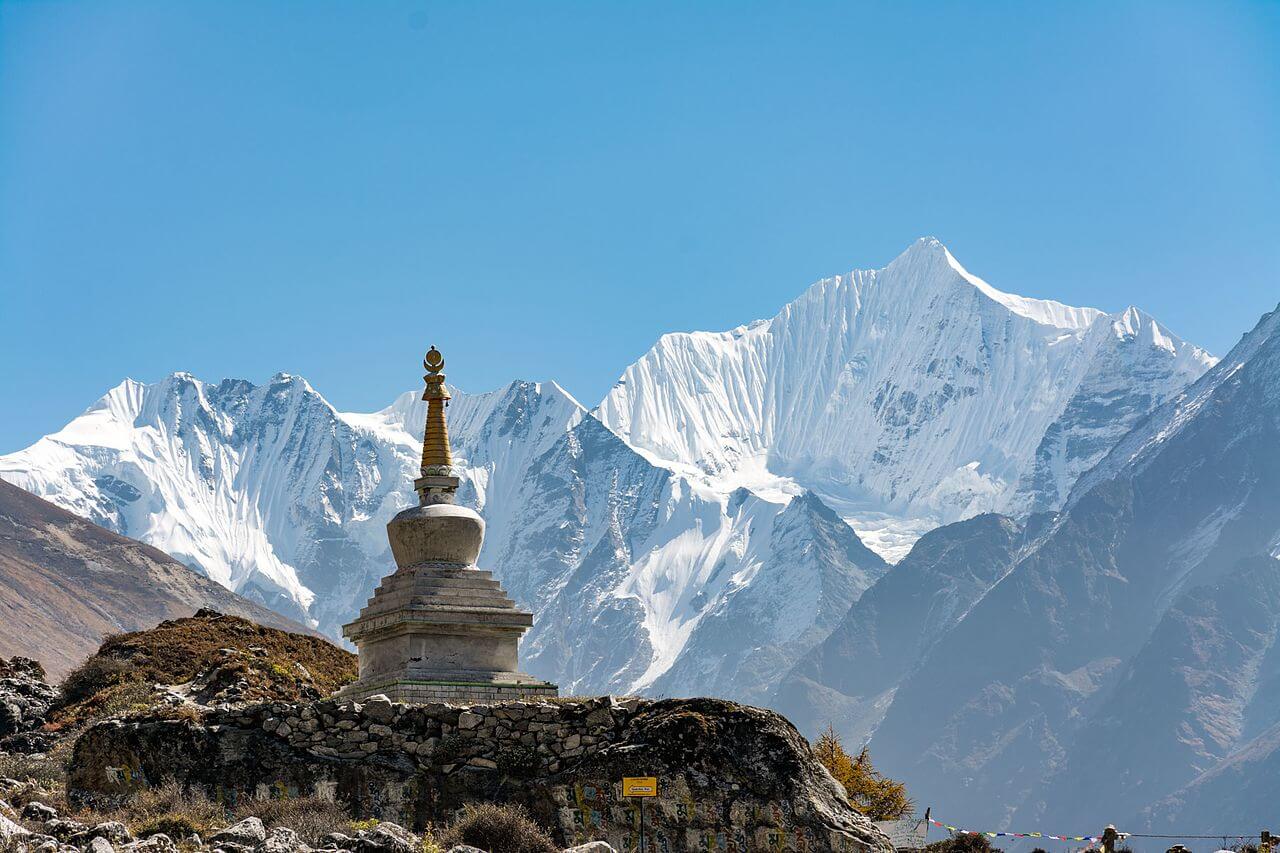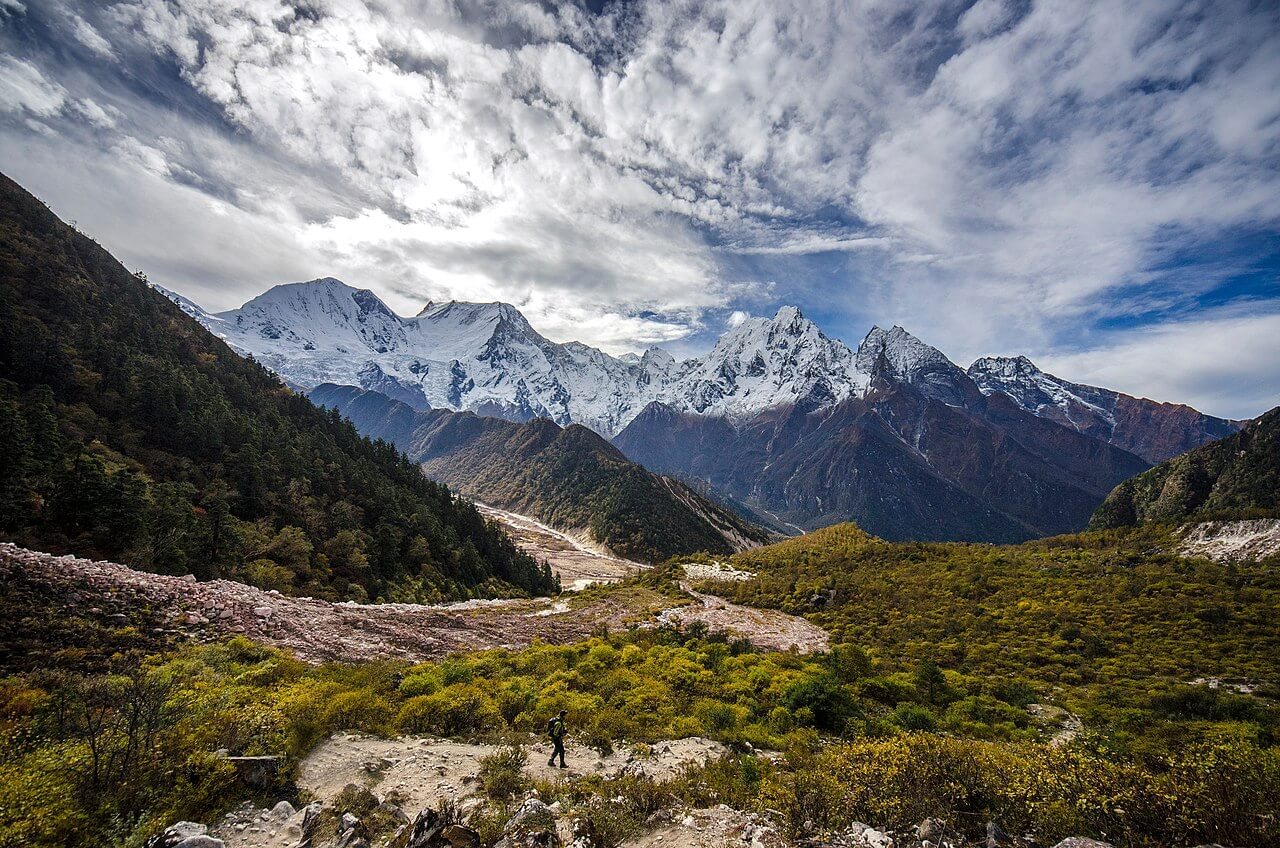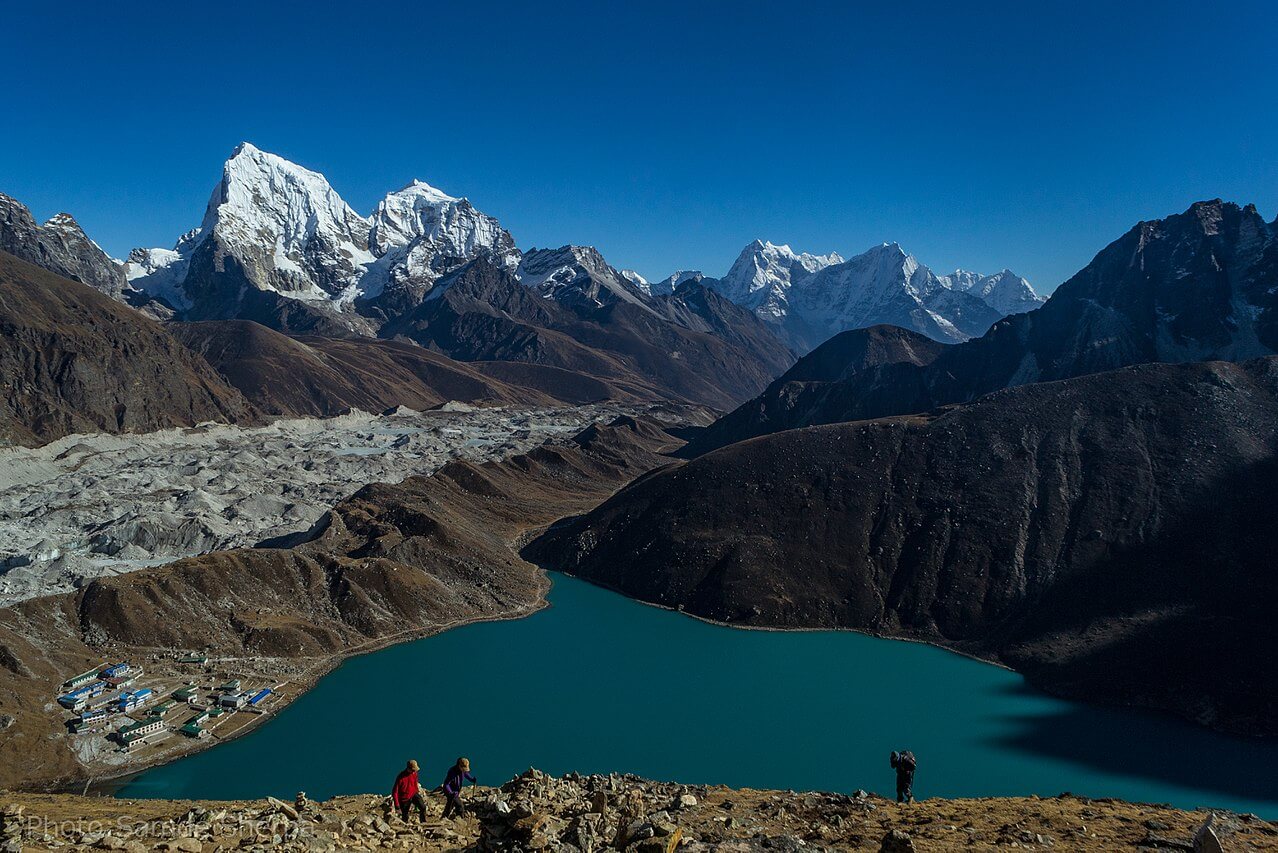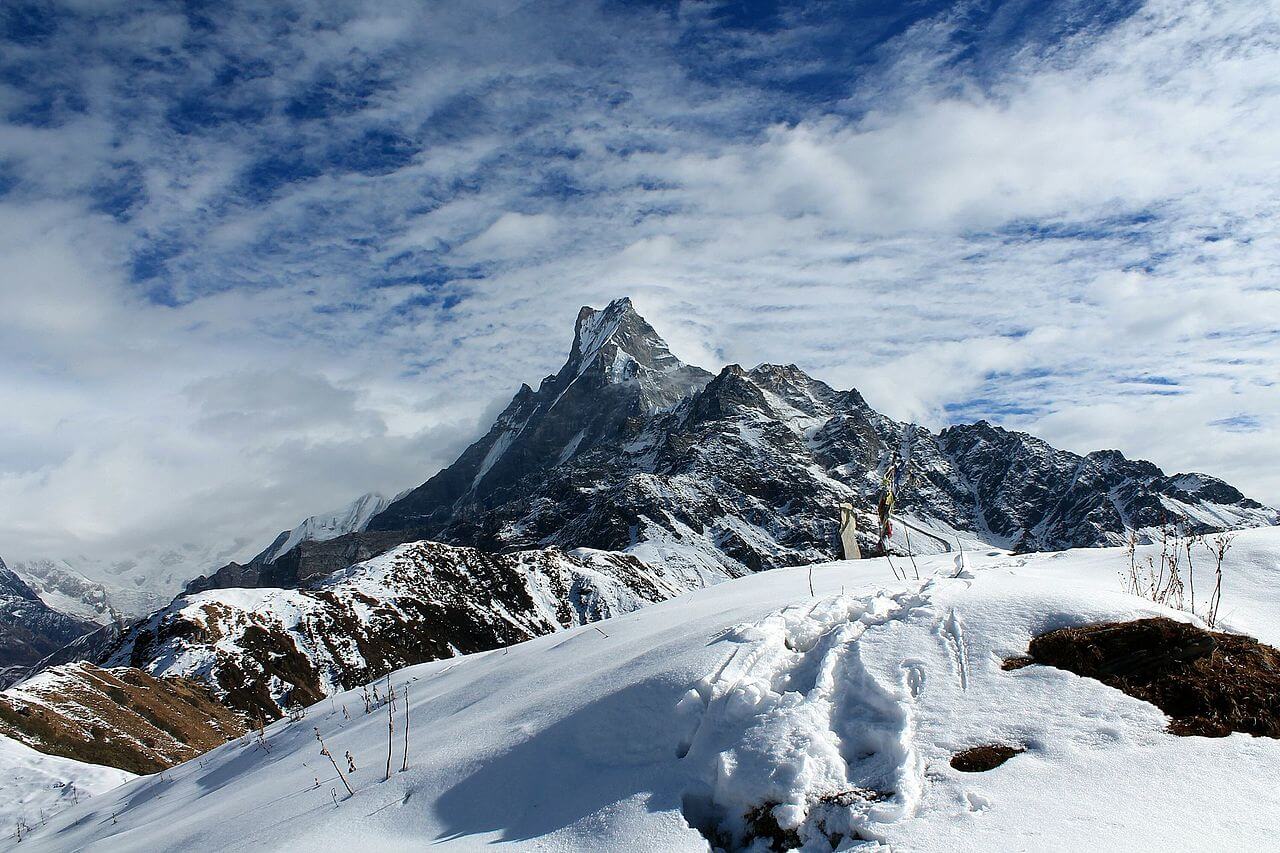Langtang Valley Trek
Langtang Valley is a classic trekking destination, located only 61.8km away from aerial distance, north of Kathmandu.
Although the Langtang Valley Trek is relatively short, accessible, and cheap, the trails are quieter with less number of trekkers compared to other classic trekking destinations in Nepal.
The trek is ideal for both experienced trekkers as well as novice travel enthusiasts. This trek provides an incredible opportunity to traverse through beautiful Tamang villages, diverse landscapes, eye-catching waterfalls, high Himalayan valleys, monasteries, and densely forested areas.
The mountain trails to Langtang also offers you a spectacular sight of the glaciers and mountains including Langtang Lirung, Ganesh Himal, Jugal Himal, Dorje Lakpa, and Ganja La Pass.
Protected as Langtang National Park, it is home to an abundance of exotic animals and birds. On a lucky day, you may spot plenty of wild animals including red panda, langur, musk deer, snow leopards, Himalayan tahr along with birds like Himalayan monal, white-winged redstart, and the snow Patridge.
Before the catastrophic earthquake in 2015, Langtang used to be one of the most commercial trekking destinations in Nepal. The region was severely affected and damaged by the earthquake. Some of the villages in the region were destroyed and buried under the rubble. However, after massive reconstruction and renovation efforts, the area is now open for the trekkers.
Table of Content
Langtang Valley Trek Facts
| Trip Duration | 8 Days |
| Maximum Altitude | 5,000m at Tserko Ri |
| Trip Difficulty | Moderate |
| Accommodation | Teahouse/Lodge |
| Walking Duration | 5-6 hours per day |
| Best Time to Trek | Autumn and Spring |
| Group Size | Minimum 1 Person |
Highlights of Langtang Valley Trek
- Langtang Valley is a relatively short and accessible trekking destination with a fantastic Himalayan experience.
- Relish the beautiful spectacles of Langtang Lirung, Ganesh Himal, Manaslu, and Jugal Himal.
- Breathtaking climb to the vantage point of Tserko Ri at the elevation of 5033m.
- Explore the beautiful Tamang villages and get a more in-depth insight into their cultures and heritages.
- Opportunity to witness rare animals like the red panda, snow leopard, langur, and musk deer.
- Explore the ancient monastery of Kyanjin Gompa.
Getting There and Away
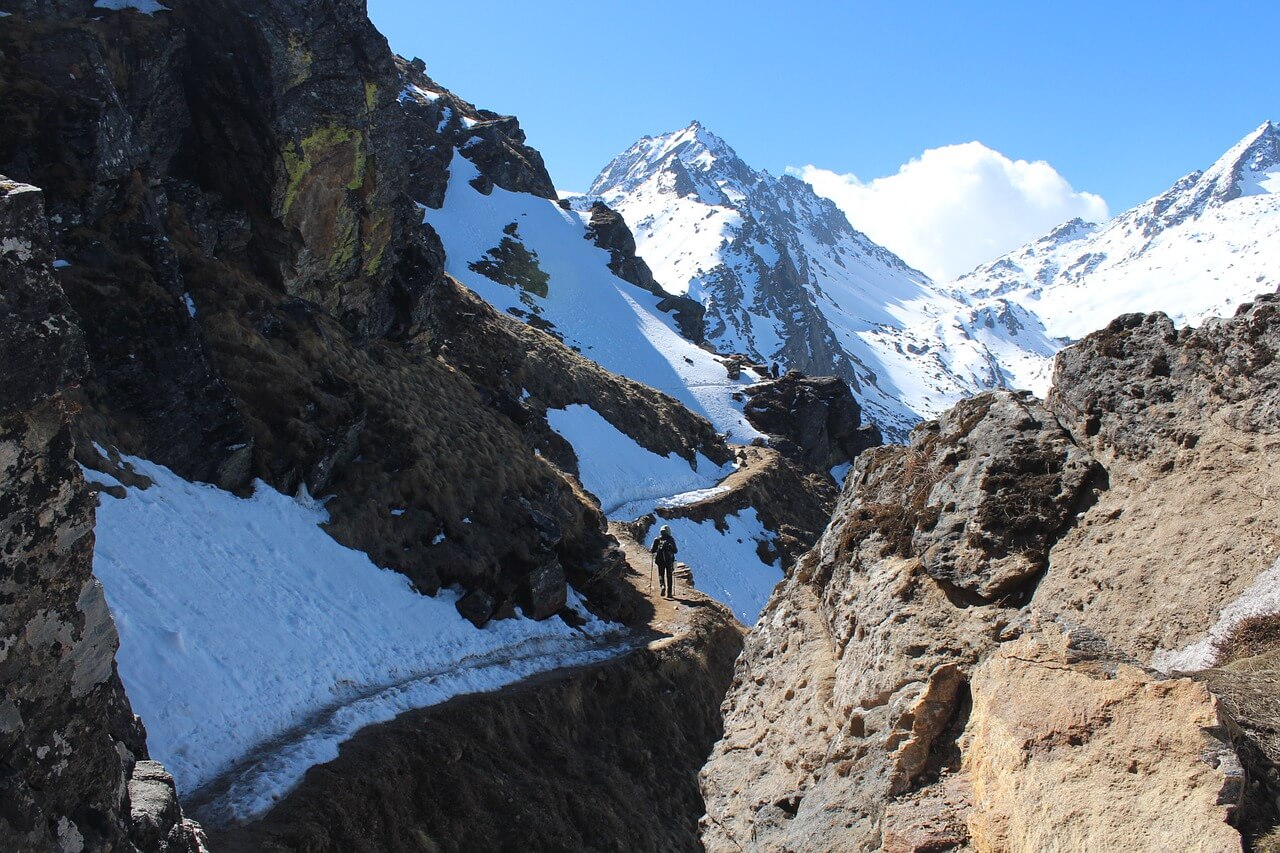
Start of the Trek
Your journey to Langtang Valley Trek begins with a 7-hour drive from Kathmandu to Syabrubesi. The drive from Kathmandu to Syabrubesi covers the total distance of 122km. Although reasonably short in distance, there is still no luxury transportation services available for this region. You can drive to Syabrubesi either by local bus or local/private jeep.
The local bus departs from Machhapokhari every morning from 7 to 9 AM. The bus fare may cost you from $6 to $8 depending upon the different transportation companies. The main discomfort while driving on a local bus is congested seats and too many passengers.
The local jeep will cost about $8 to $10 per person on a sharing basis. You can take these jeeps from Machhapokhari as well. They depart every morning from 6:30 to 9 AM.
If you’re willing to hire a private jeep, it’ll cost you around $150 for a group of 6-7 travelers.
The road condition you travel along reveals its pathetic and rough forms. The highway from Kathmandu to Trishuli Bazaar is good with a narrow winding road. However, once you drive further from Trishuli Bazaar, the road becomes rough and bumpy. Along the way, you come to experience some dreadful landslides.
End of the Trek
Since both starting point and endpoint of Langtang Valley Trek is at Syabrubesi, you’ll be retracing the route backward from Syabrubesi to Kathmandu at the end of the trek.
You’ll have similar transportation options while traveling from Syabrubesi to Kathmandu.
Outline Itinerary of Langtang Valley Trek – 8 Days
| Day | Itinerary | Altitude from (Meters) | Altitude to (Meters) | Trekking Duration |
|---|---|---|---|---|
| 1 | Drive from Kathmandu to Syabru Besi | 1,400 | 1,550 | 7-8 hrs |
| 2 | Trek from Syabru Besi to Lama Hotel | 1,550 | 2,380 | 6-7 hrs |
| 3 | Trek from Lama Hotel to Mundu via Langtang Valley | 2,380 | 3,430 | 6-7 hrs |
| 4 | Trek from Mundu to Kyanjin Gompa | 3,430 | 3,870 | 3 hrs |
| 5 | Excursion to Tserko Ri (5,000m) | 3,870 | 3,870 | 5-6 hrs |
| 6 | Trek from Kyanjin Gompa to Lama Hotel | 3,870 | 2,380 | 6-7 hrs |
| 7 | Trek from Lama Hotel to Syabru Besi | 2,380 | 1,550 | 6-7 hrs |
| 8 | Drive from Syabru Besi to Kathmandu | 1,550 | 1,400 | 7-8 hrs |
Lantang Valley Trek Detailed 8 Days Itinerary
Day 1: Drive from Kathmandu (1,400m) to Syabru Besi (1,550m) – 7 to 8 hours
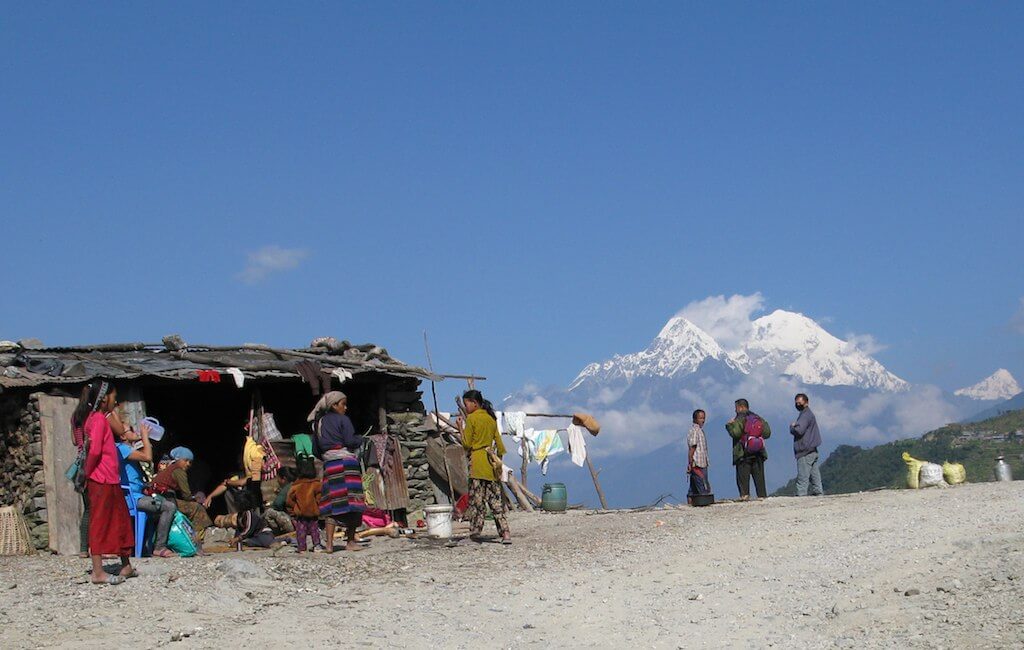
The adventure of Langtang Valley Trek begins with a 7-hour drive from Kathmandu to Syabru Besi. You can either take a local bus from Macchapokhari or hire a jeep to Syabru Besi.
As soon as the bus departs from Kathmandu, the road climbs over the ridge offering majestic views of Ganesh Himal, Manaslu, and Annapurna. The condition of the highway is extremely rocky and rough with tons of potholes and small ditches.
You’ll be driving alongside the Trishuli river for most of the day. Driving past the bustling town of Trisuli, the road leads towards Dhunche, the administrative center of Rasuwa District. Make sure to keep your TIMS card and National Park Permit in an easily accessible place as you’ll need to show them at the Park Gate right before Dhunche. After driving for another hour downhill from the town of Dhunche, you’ll reach Syabru Besi.
Day 2: Trek from Syabru Besi (1,550m) to Lama Hotel (2,380m) – 6 to 7 hours
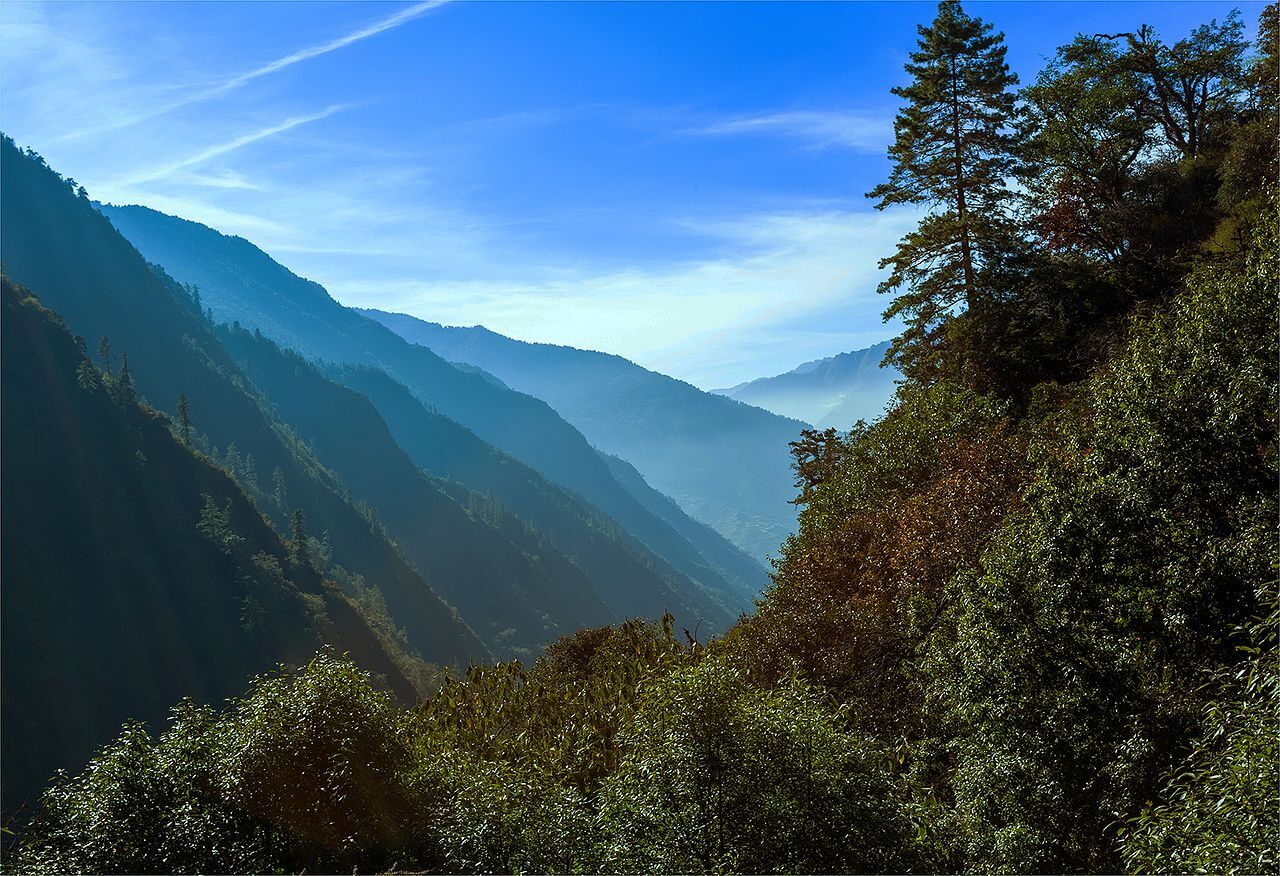
You’ll start the trek from Syabru Besi by crossing the bridge over the Ying Yang River. The trail ascends and descends simultaneously through the dense sub-tropical forest alongside Langtang Khola.
As the trek continues, oak and rhododendron trees dominate the surroundings. While walking in the woods, make sure to watch out for the langur monkeys. The trail goes steep and slightly strenuous through the forest up to Lama Hotel.
Day 3: Trek from Lama Hotel (2,380m) to Mundu (3,430m) via Langtang Village – 6 to 7 hours
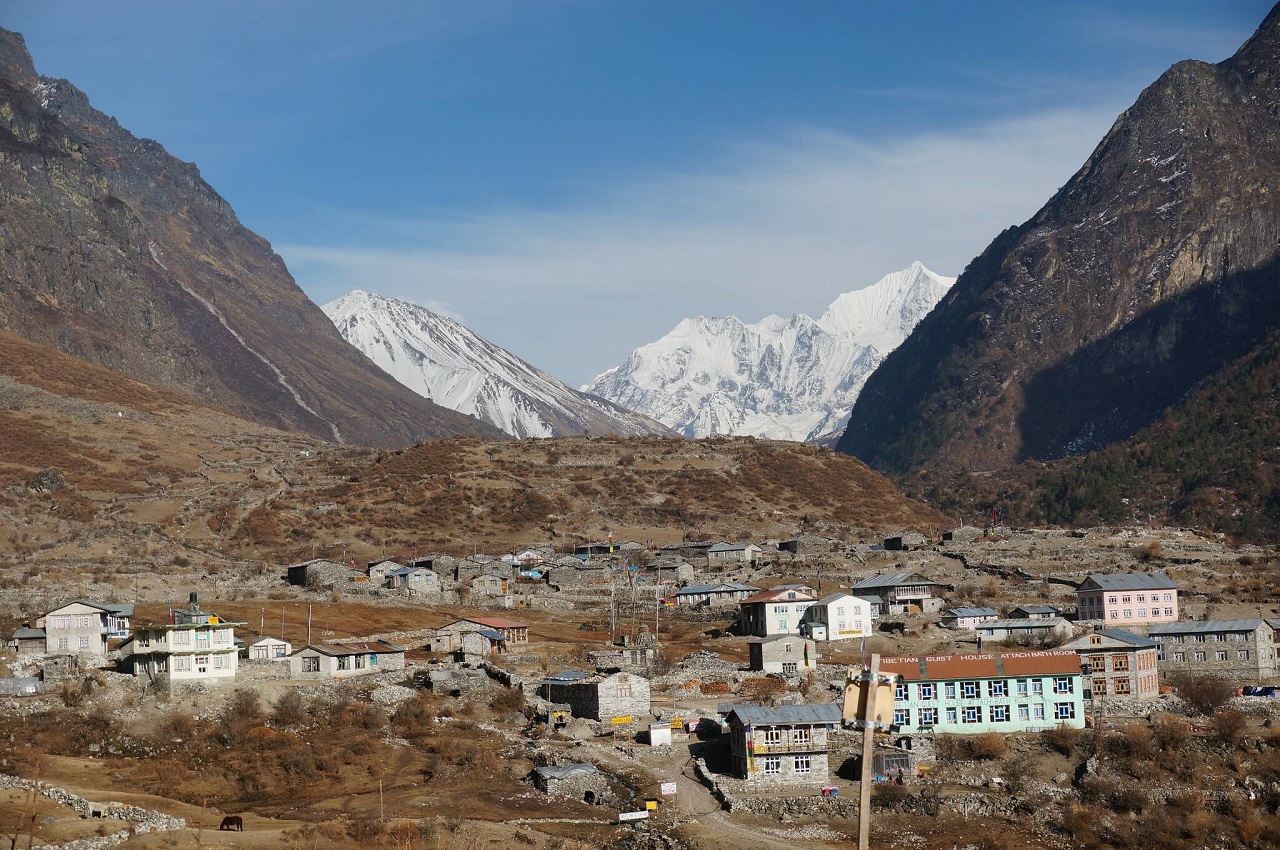
On this day, the forest trail continues through plenty of waterfalls and occasional glimpses of Langtang Lirung. At Ghoda Tabela, the path emerges out of the woodlands into the lush green meadow. The snow-capped peaks of the Langtang range begin to appear on either side of the valley.
The trail further continues to a gentle uphill, passing a few temporary settlements towards Langtang village. Before the 2015 earthquake, Langtang village was once a bustling settlement with plenty of teahouses and lodges. A massive rock field surrounds the entire valley. Mundu village is only half an hour away from Langtang village.
Day 4: Trek from Mundu (3,430m) to Kyanjin Gompa (3,870m) – 3 hours
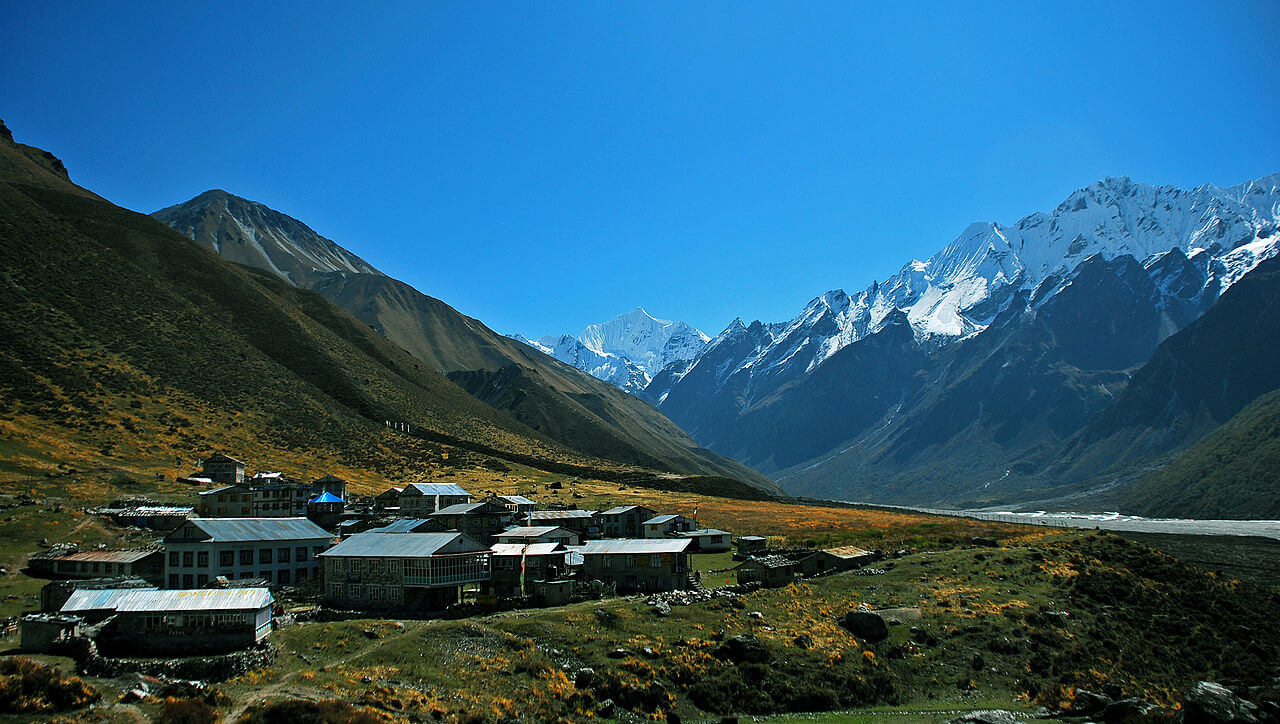
Today, the trail continues gradually passing water mills, chortens, prayer flags, and sacred mounds of rocks with carved inscriptions. The route heads upwards to a yak pasture where the sight becomes more extensive with the mountain views.
As you cross over some moraines and small streams, you’ll reach Kyanjin Gompa. Since this is the shortest day of the trek, you’ll arrive at Kyanjin Gompa by lunchtime. So, if you do not want to spend the day resting, we recommend you head towards Langshisha Kharka for incredible views.
Day 5: Excursion to Tserko Ri (5,000m) – 5 to 6 hours
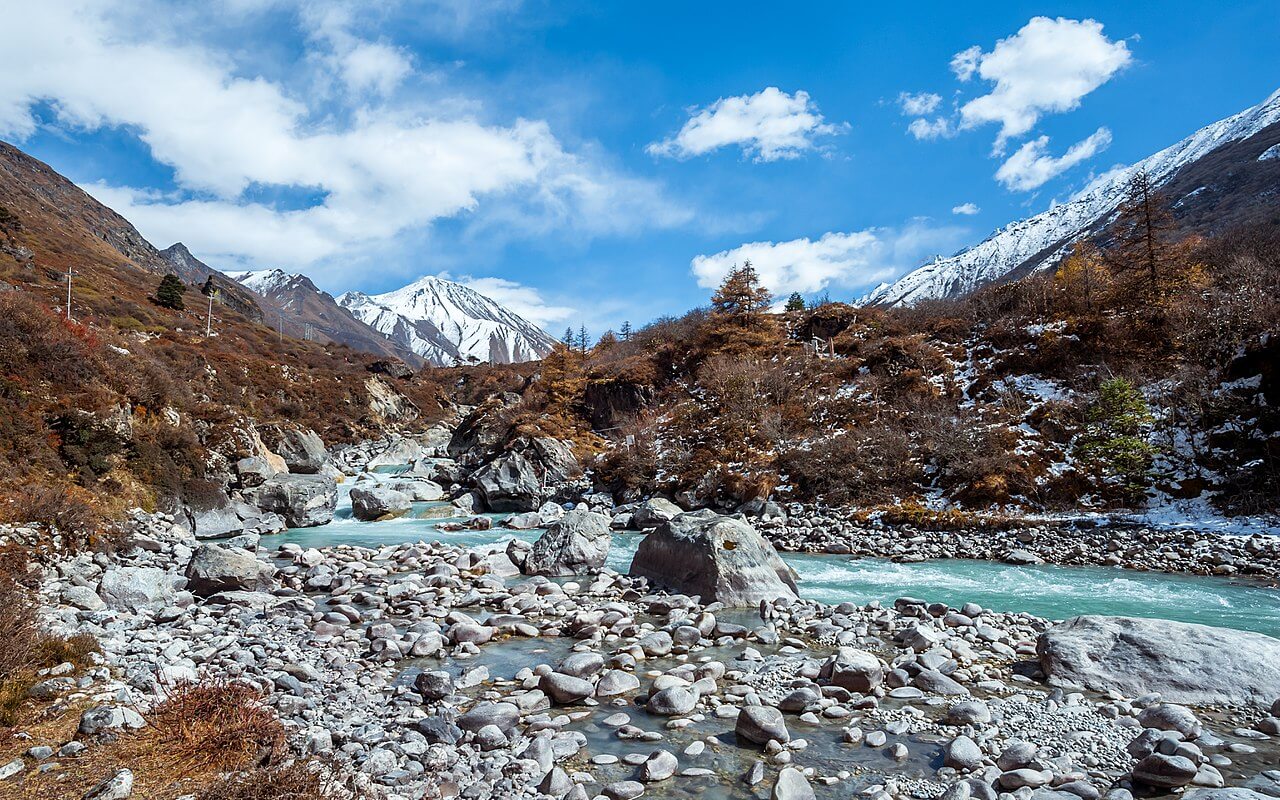
Hike up to the vantage point at Tserko Ri to relish the incredible sights of the mountains, glaciers, and the Langtang valley. Tserko Ri marks the highest elevation point of the trek at 5,000m above sea level.
Since you’ll return to Kyanjin Gompa by the afternoon, you can also explore the ancient monastery of the village. Additionally, you can also visit the cheese factory and glacier.
Day 6: Trek from Kyanjin Gompa (3,870m) to Lama Hotel (2,380m) – 6 to 7 hours
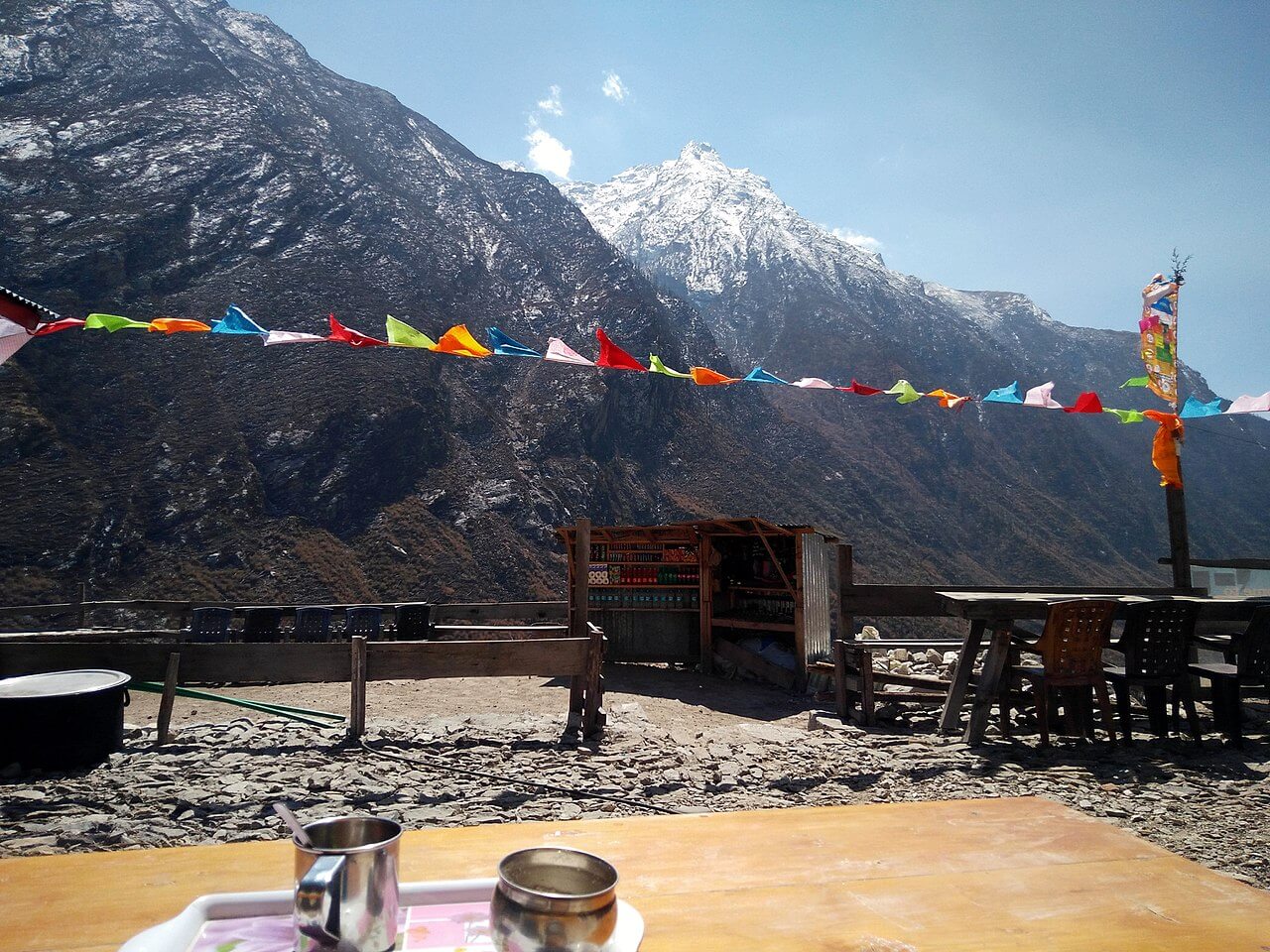
On this day, you retrace the route from Kyanjin Gompa back to Lama Hotel. The way follows back alongside the Langtang River through Mundu village to Ghoda Tabela. The trail is mostly downhill throughout the day. Upon reaching Ghoda Tabela, you’ll continue descending on a steep downhill to Lama Hotel.
Day 7: Trek from Lama Hotel (2,380m) to Syabru Besi (1,550m) – 6 to 7 hours
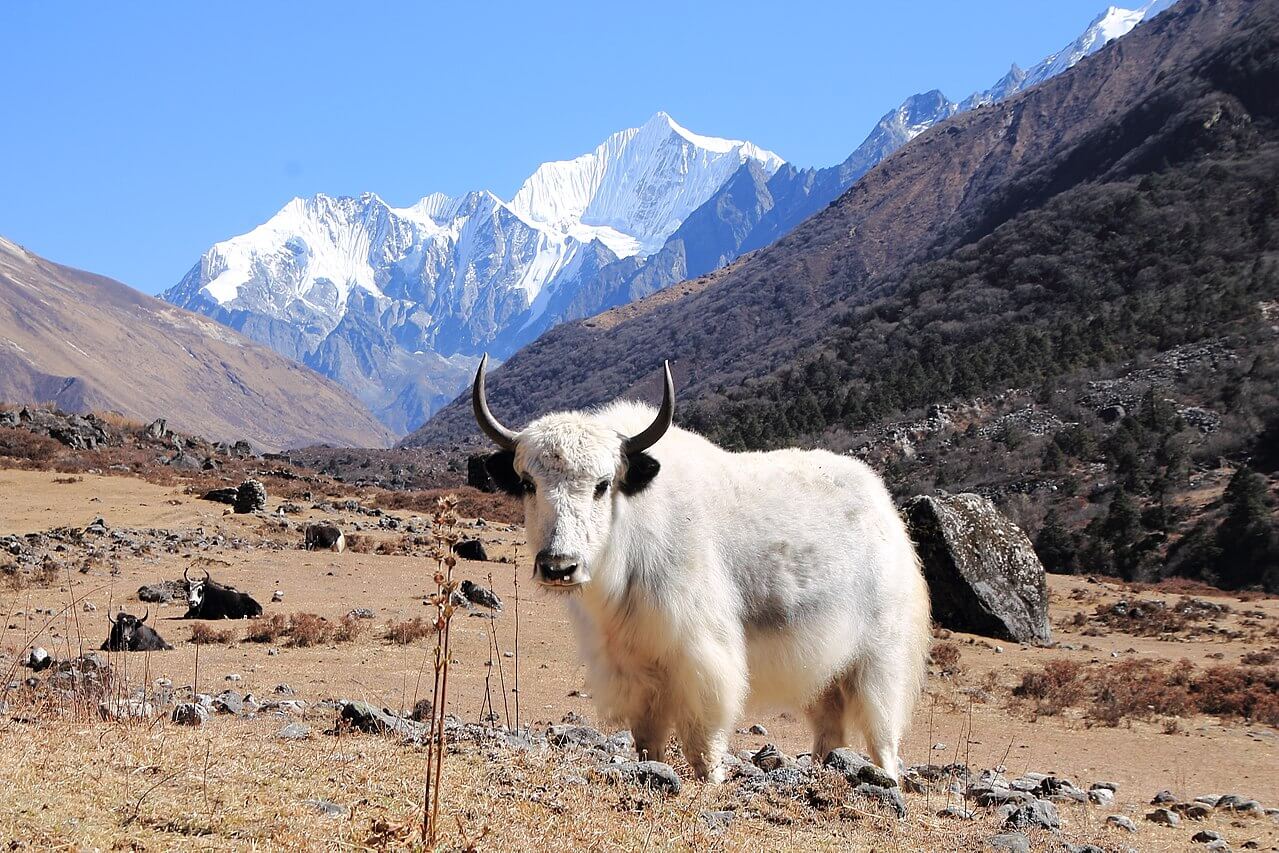
Two different trails lead to Syabru Besi. You can either retrace the route enjoying the forest from Lama Hotel or you can take a detour from Rimche via Sherpa Gaun to Syabru Besi.
The detour from Rimche takes much longer to arrive at Syabru Besi, but this spectacular route is worth the time.
Day 8: Drive from Syabru Besi (1,550m) to Kathmandu (1,400m) – 8 to 10 hours
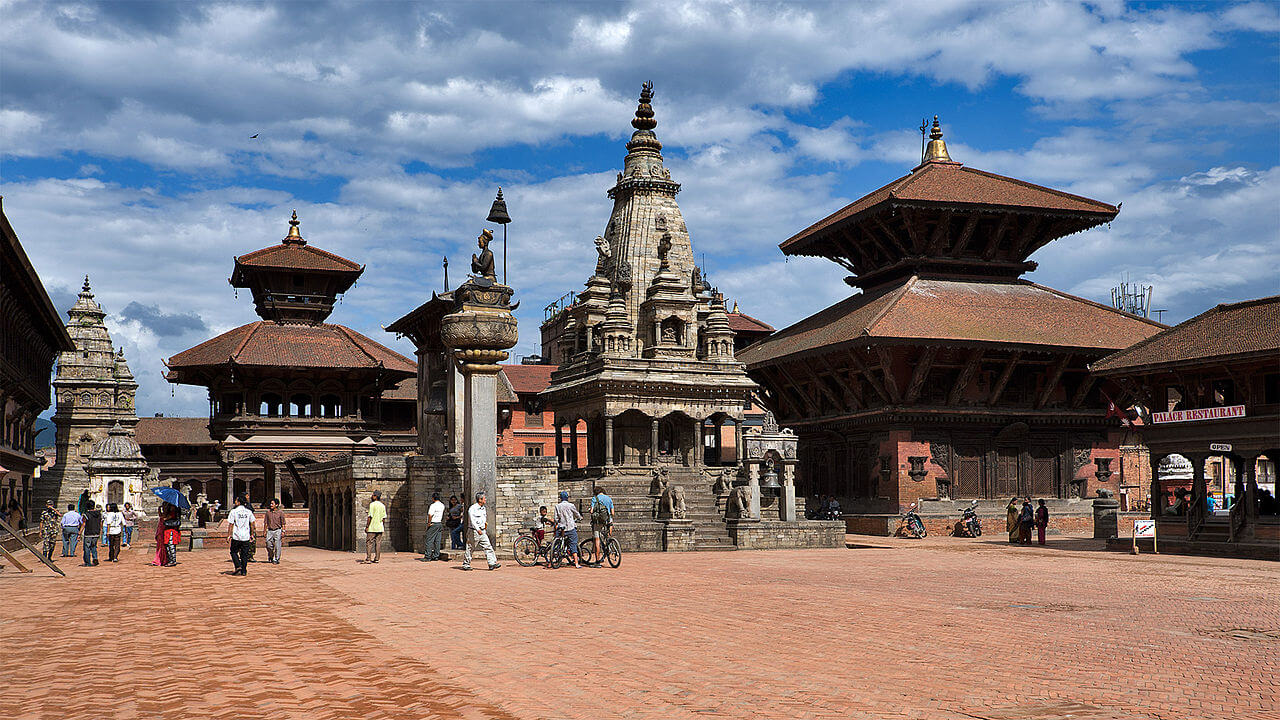
On the final day, you drive back from Syabru Besi to Kathmandu. If you’re early, you can catch a local bus from here. Otherwise, you can also take a local jeep for a slightly convenient experience. It takes about 7-8 hours to drive from Syabru Besi to Kathmandu.
Langtang Valley and Gosainkunda Extension
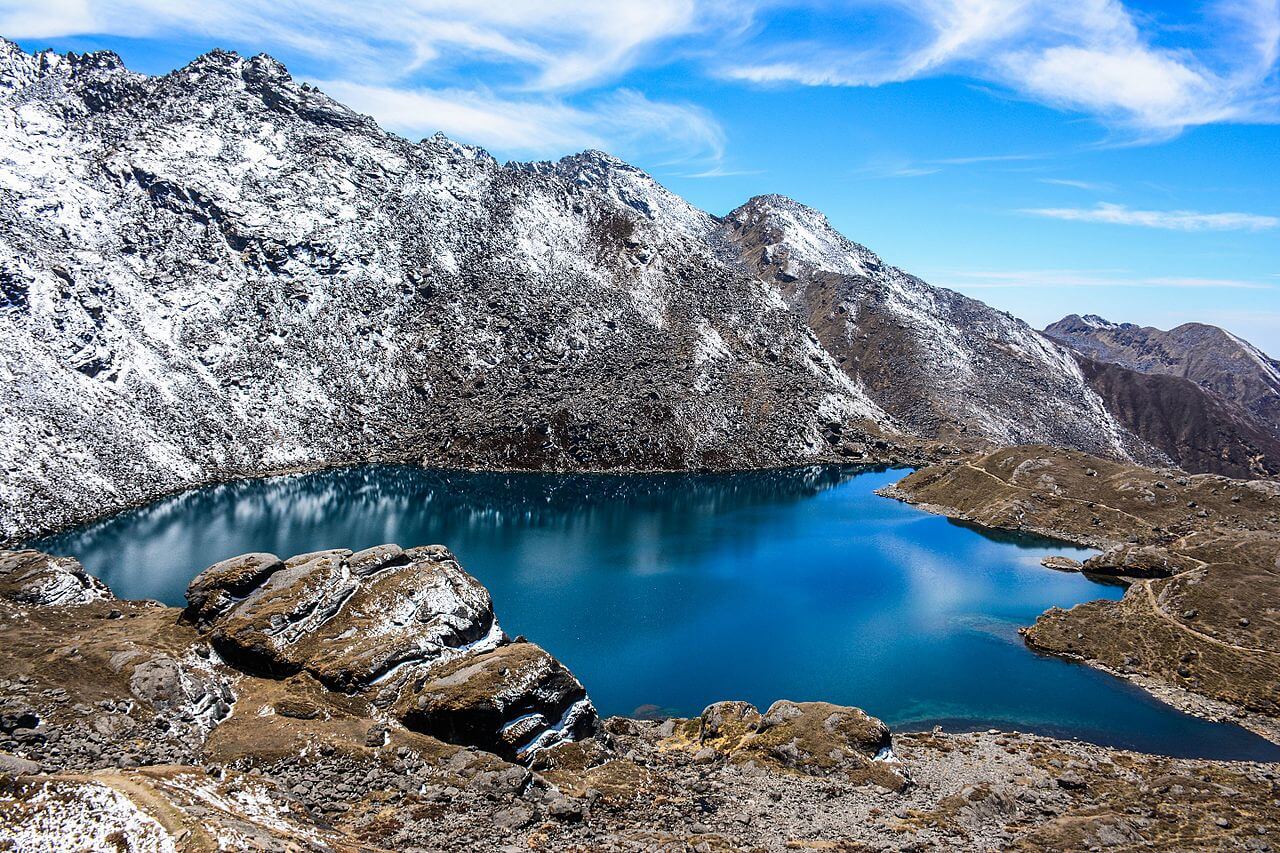
If time permits, you can combine the Langtang Valley Trek with Gosainkunda. The trek offers remote trails with spectacular views of the mountains at Langtang and high Himalayan lake at Gosainkunda.
Gosainkunda, a holy glacial lake at an elevation of 4,380m, is a shrine of Hindus. The diverse landscapes, lush green forest, terraced fields, hills, and scenic mountain views make Gosainkunda one of the most stunning trekking destinations in Nepal.
Langtang Valley Trek with Gosainkunda Extension begins with a drive from Kathmandu to Syabru Besi and then follows through the Langtang Valley. The trail to Gosainkunda connects from Thulo Syapru while retracing the route back from Langtang Trek. The path is quite steep from Thulo Syabru to Sing Gompa and up to the pristine lake of Gosainkunda.
| Day | Itinerary | Altitude from (Meters) | Altitude to (Meters) | Trekking Duration |
|---|---|---|---|---|
| 1 | Drive from Kathmandu to Syabru Besi | 1,400 | 1,550 | 7-8 hrs |
| 2 | Trek from Syabru Besi to Lama Hotel | 1,550 | 2,380 | 6-7 hrs |
| 3 | Trek from Lama Hotel to Mundu via Langtang Valley | 2,380 | 3,430 | 6-7 hrs |
| 4 | Trek from Mundu to Kyanjin Gompa | 3,430 | 3,870 | 3 hrs |
| 5 | Excursion to Tserko Ri (5,000m) | 3,870 | 3,870 | 5-6 hrs |
| 6 | Trek from Kyanjin Gompa to Lama Hotel | 3,870 | 2,380 | 6-7 hrs |
| 7 | Trek from Lama Hotel to Thulo Syabru | 2,380 | 2,260 | 5-6 hrs |
| 8 | Trek from Thulo Syabru to Sing Gompa | 2,260 | 3,330 | 4-5 hrs |
| 9 | Trek from Sing Gompa to Gosainkunda Lake | 3,330 | 4,380 | 5-6 hrs |
| 10 | Trek from Gosainkunda Lake to Sing Gompa | 4,380 | 3,330 | 4-5 hrs |
| 11 | Trek from Sing Gompa to Dhunche | 3,330 | 2,030 | 6 hrs |
| 12 | Drive from Dhunche to Kathmandu | 2,030 | 1,400 | 6-7 hrs |
Best Time to Travel in Langtang Region
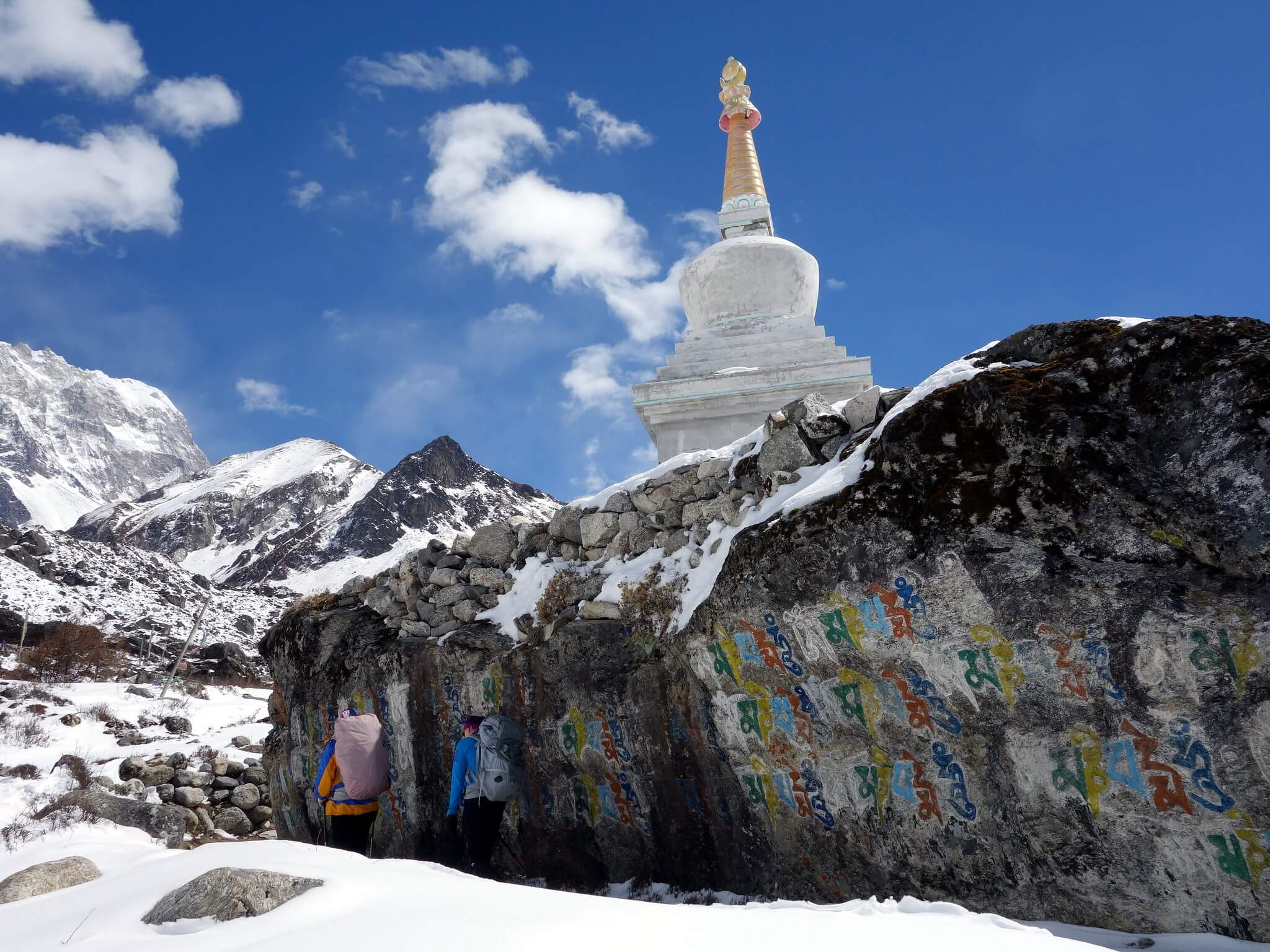
Trekking to Langtang Valley is possible throughout the year. However, Spring season (March to May) right after the cold winter and in Autumn season (September to November) right after the soaking monsoon are two most popular periods to visit the Langtang region.
In most of the days during the Autumn, the temperature remains moderate with a crystal clear sky. This means the temperature during this time of the year is perfect for walking. Also, you get to witness the incredible scenery of the Himalayas throughout the trek. However, the only drawback to trek at this time of the year is the crowded trails.
During the spring season, the temperature is slightly warmer during the day, and the sky looks hazy at times. This means the view may not be as exceptional as the Autumn.
Winter brings cold and harsh weather, especially at the higher elevations. Thick snow covers the trails making it hard to walk during winter. However, the skies are unclouded and reward magnificent sights. If you’re planning to trek to Langtang Valley during the winter, make sure to pack warm clothes and high-quality sleeping bags.
Monsoon is the least favorable time to go trekking in Langtang. The temperature is far too unstable with wet and slippery trails. Since dense forests dominate this region, the risk of leeches increases extensively. Trekking in monsoon demands proper preparation and packing.
Here’s a table indicating the details of average temperature and rainfall of different places en-route to Langtang Valley Trek:
| Location | Elevation (meters) | Average Minimum Temperature (°C) | Average Maximum Temperature (°C) | Annual Rainfall (mm) |
|---|---|---|---|---|
| Kathmandu | 1,400 | 10.1 | 23.6 | 1505 |
| Syabru Besi | 1,550 | 10.6 | 22.7 | 1857 |
| Lama Hotel | 2,380 | 3.9 | 15.5 | 1233 |
| Kyanjin Gompa | 3,870 | -3 | 10.2 | 556 |
How Difficult is Langtang Valley Trek?
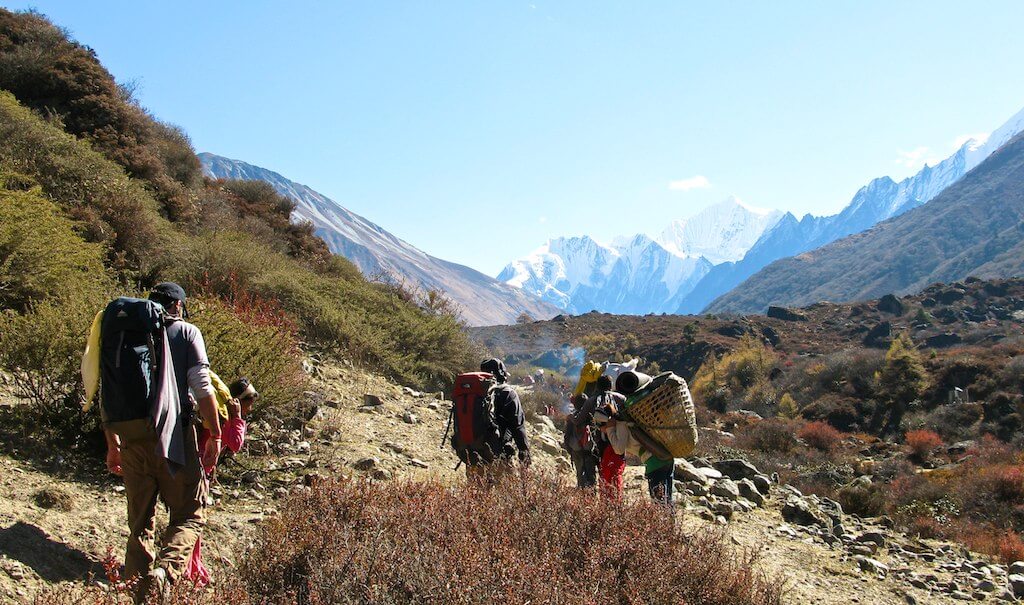
Langtang Valley Trek is a short and moderate trek that does not require any technical skills or previous trekking experience. You can complete the entire trek in 8 to 10 days, walking 5 to 7 hours per day.
The most challenging section of Langtang Trek is the hike from Kyanjin Gompa to Tserko Ri. The trail to Tserko Ri is mostly steep uphill on the rocky Himalayan terrain. However, on most days, the path is easy and comfortable with a pleasant walk.
The highest elevation point in Langtang Valley Trek is 5,000m above sea level. Therefore, Acute Mountain Sickness (AMS) is one of the significant threats while trekking in Langtang. You are required to take all the necessary precautions while traveling in such high elevation. Insist on drinking plenty of water, and be aware of the symptoms of AMS.
The weather in the Himalayas is always unpredictable, especially in the upper reaches. Therefore, it is essential to pack all the necessary equipment while trekking in Langtang Valley. If you’re planning to trek during monsoon season, stay cautious on the trail. There are plenty of landslide-prone areas en-route to Langtang Valley.
While this trek may be relatively easy for experienced trekkers, it does demand a certain level of physical fitness and attitude. One proper way to keep yourself fit for the trek is to engage in cardio-oriented exercises.
What Permits are Requied for Langtang Valley Trek?
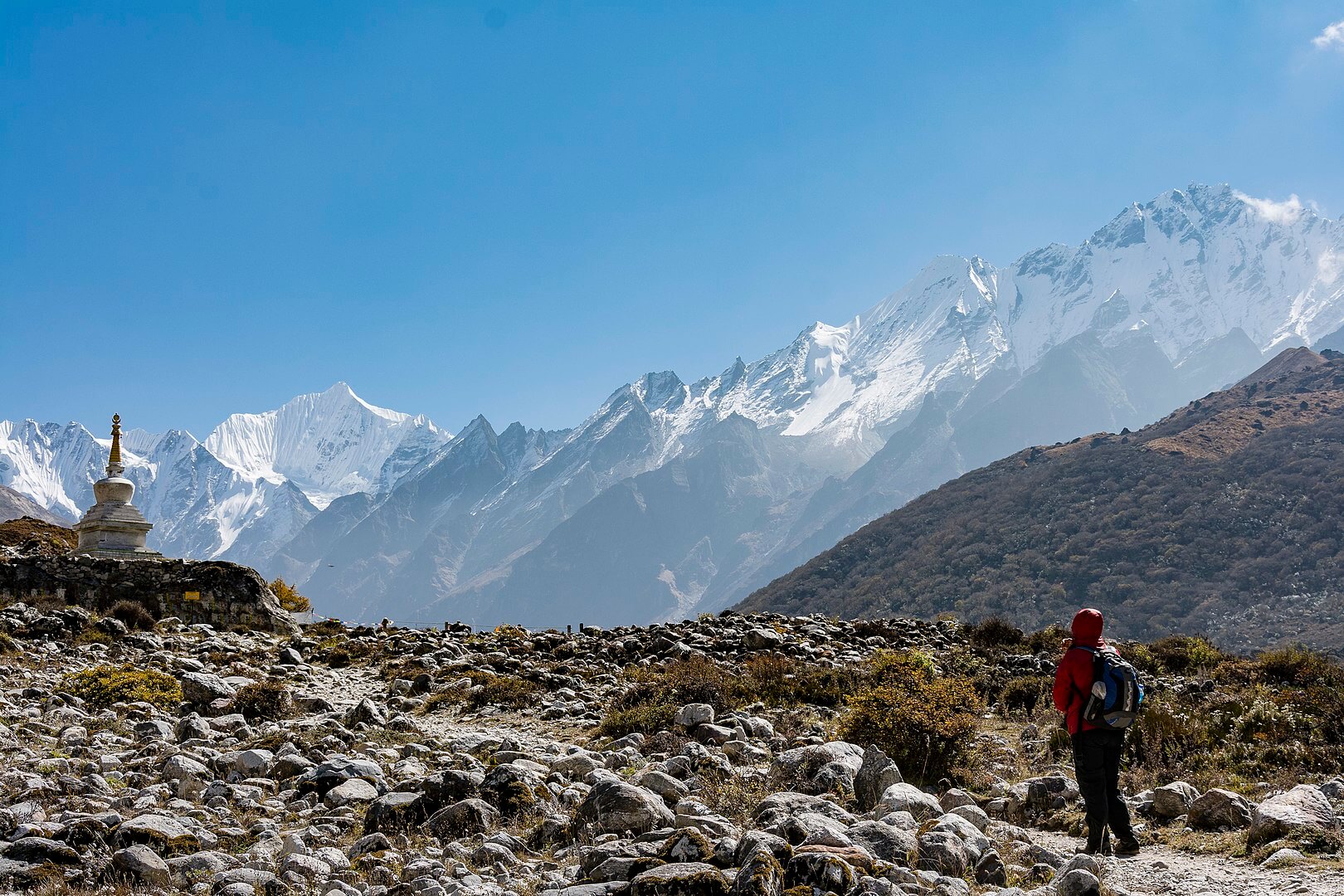
You only require two different permits — TIMS Card (Trekking Information Management System) and Langtang National Park Entry Permit, while trekking to Langtang Valley.
There are three types of TIMS Card; blue for organized group trekkers, green for individual travelers, and a pink one for SAARC nationals. You can acquire TIMS Card from Nepal Tourism Board (NTB) or Trekkers Agencies’ Association of Nepal (TAAN) Secretariat in Kathmandu.
Since you’ll be trekking through the Langtang National Park also need an exclusive National Park Permit to enter the area. The permit is available in Nepal Tourism Board in Kathmandu, or you can also get them from the entry gate at Dhunche.
While issuing a TIMS Card, you’ll require your passport, four passport size photos, insurance details, and contact details of someone in Nepal.
Here’s the price of the permits required for Langtang Valley Trek:
| Required Permits | For International Countries | For SAARC Countries |
|---|---|---|
| TIMS Card | For Individual: NPR 2000/US$ 18 For Group: NPR 1000/ US$ 9 | For Individual: NPR 300/ US$ 2 For Group: NPR 600/ US$ 4 |
| Langtang National Park Entry Permit | NPR3000/ US$ 27 | NPR 1500/ US$ 14 |
Insurance for the Trek
Having travel insurance is an excellent idea if you’re planning to trek to Langtang Valley. While trekking in such high elevations, you may come across unexpected situations. Therefore, it is essential to get travel insurance for Langtang Trek.
Make sure to choose a policy that covers emergency helicopter evacuation, medical costs, natural disasters, theft, and losses. While several companies provide travel insurance, we advise you to get it from World Nomads. The best thing about World Nomads is that you can claim, buy, or extend the policy anytime online from anywhere — even while traveling.
Guided VS Independent
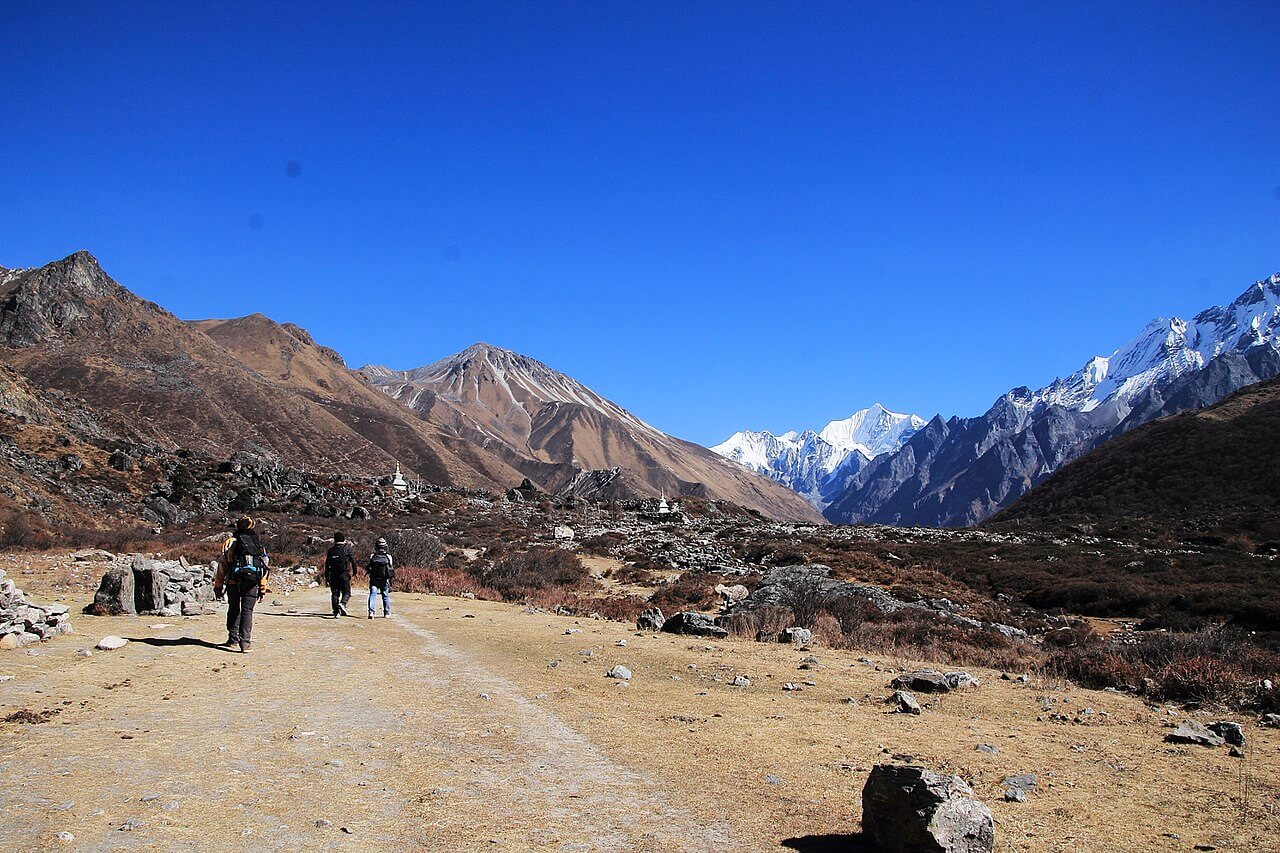
Since Langtang Valley Trek is a moderate walk, you can do it both independently or with a guide. If you’re planning a solo adventure and have prior trekking experience, this trek is an excellent choice for you. The route does not disperse into other trails, and occasional signposts mark the entire trail. Therefore, the risk of taking the wrong path is very minimal.
Altitude is the primary threat while trekking to Langtang Valley. Stay aware and precautious regarding this factor.
Trekking independently is relatively cheaper than hiring a guide, but you need to deal with hassles of transportation, teahouses, food and permit. It is always handy to have an experienced guide at high altitude treks. The guide will assist you throughout the trek and will make sure of your safety.
An experienced guide will also know about the place, culture, people, and the mountains. You’ll also get more in-depth information about the valley if you hire an experienced guide.
Accommodation and Food
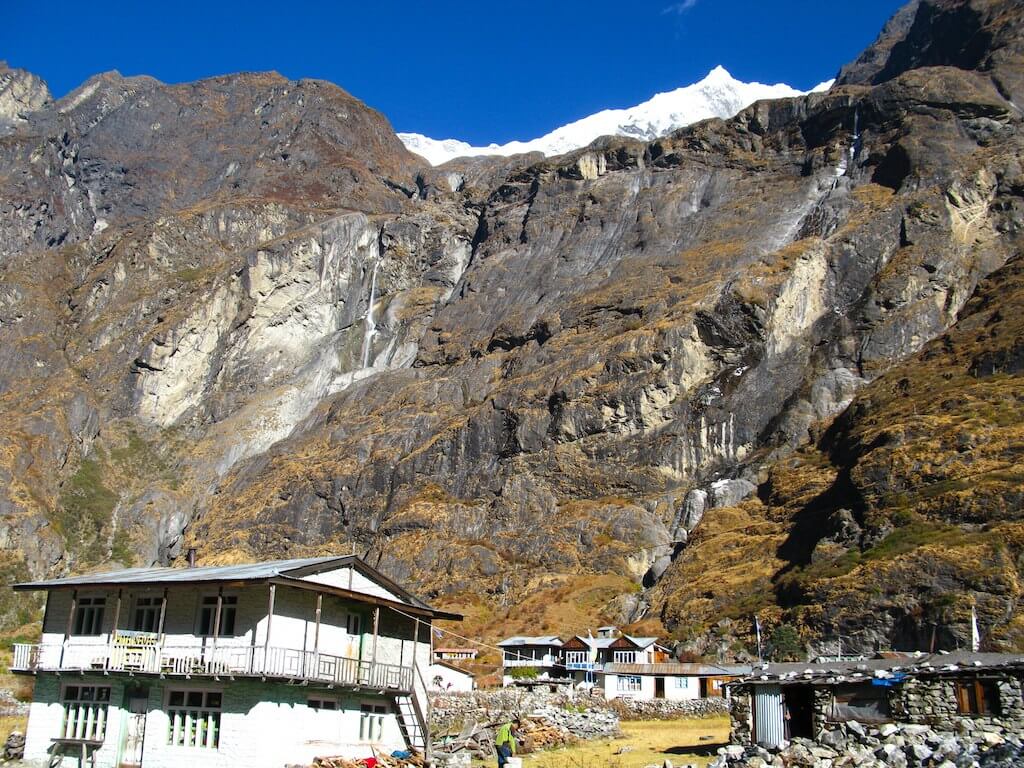
On Langtang Valley Trek, you will mostly stay at the teahouses, which provide rooms, food, and basic amenities like wifi, hot shower, and charging facilities. On the lower reaches of Langtang Valley Trek, you will get high standard rooms with attached bathrooms. These teahouses will offer standard services but may charge you higher than normal rates. Some of the teahouses provide device charging facilities at free of cost.
As you get higher on the trail, teahouses provide only essential services with twin shared rooms. The rooms have two single beds, a thin mattress, a pair of bedsheets, and a cushion. The toilets are usually on a sharing basis without the facility of running water. You’ll have to pay the additional amount for a hot shower, wifi, and charging facilities.
These teahouses also have their restaurant, serving meals to the guests. The choices in the menu are limited, but portions of the food will be quite substantial and filling. Generally, the menu offers Dal Bhat, chowmein, omelet, fried potatoes, pancakes, Tibetan bread, and soups. The non-veg items include yak meat, canned fish, and chicken.
Langtang Valley Trek Cost
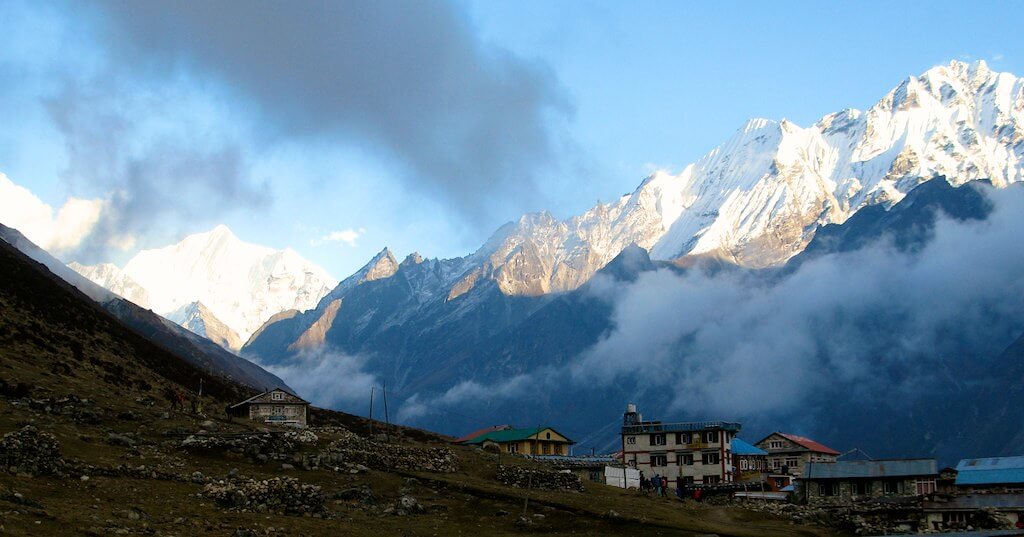
The plenty of factors like trek duration, transportation, type of trek, and season determine the cost of the trek. On average, the total cost of 8-day Langtang Valley Trek can be around US$ 300-400.
You’ll require TIMS Card and Langtang National Park Entry Permits to trek to Langtang Valley. For individual trekkers, the cost of the TIMS Card is US$ 18 while for group trekkers, it is US$ 9 her head. Additionally, the National Park Entry Permit costs US$ 27 per person.
The charge of the teahouses depends on season. Generally, the rooms in Langtang will cost approximately US$ 5 to 10 per night with an additional US$ 4 to 6 per meal.
A local bus from Kathmandu to Syabru Besi will cost about US$ 6-8 per person at par various transport companies. You can also take a local jeep that will cost you around US$ 8-10. Additionally, you can also hire a private jeep for $150 for a group of 6 to 7 people.
If you hire a licensed guide, they will charge you US$ 22 to 25 per day. If you hire a porter, it’ll cost you approximately US$ 15 to 18 per day. If you want to hire a porter-guide, they’ll charge you US$ 18 to 20 per day.
| Services | Cost |
|---|---|
| TIMS Card | For Individual:US$ 18 For Group: US$ 9 |
| Langtang National Park Entry Permit | US$ 27 per person |
| Teahouses | US$ 5-10 per day |
| Meals | US$ 4-6 per meal |
| Local Bus | US$ 6-8 per person |
| Local Jeep | US$ 8-10 per person |
| Private Jeep | US$ 150 per group (6-7 people) |
| Trekking Guide | US$ 22-25 per day |
| Porter | US$ 15-18 per day |
| Porter - Guide | US$ 18-20 per day |
Packing List for Langtang Valley Trek
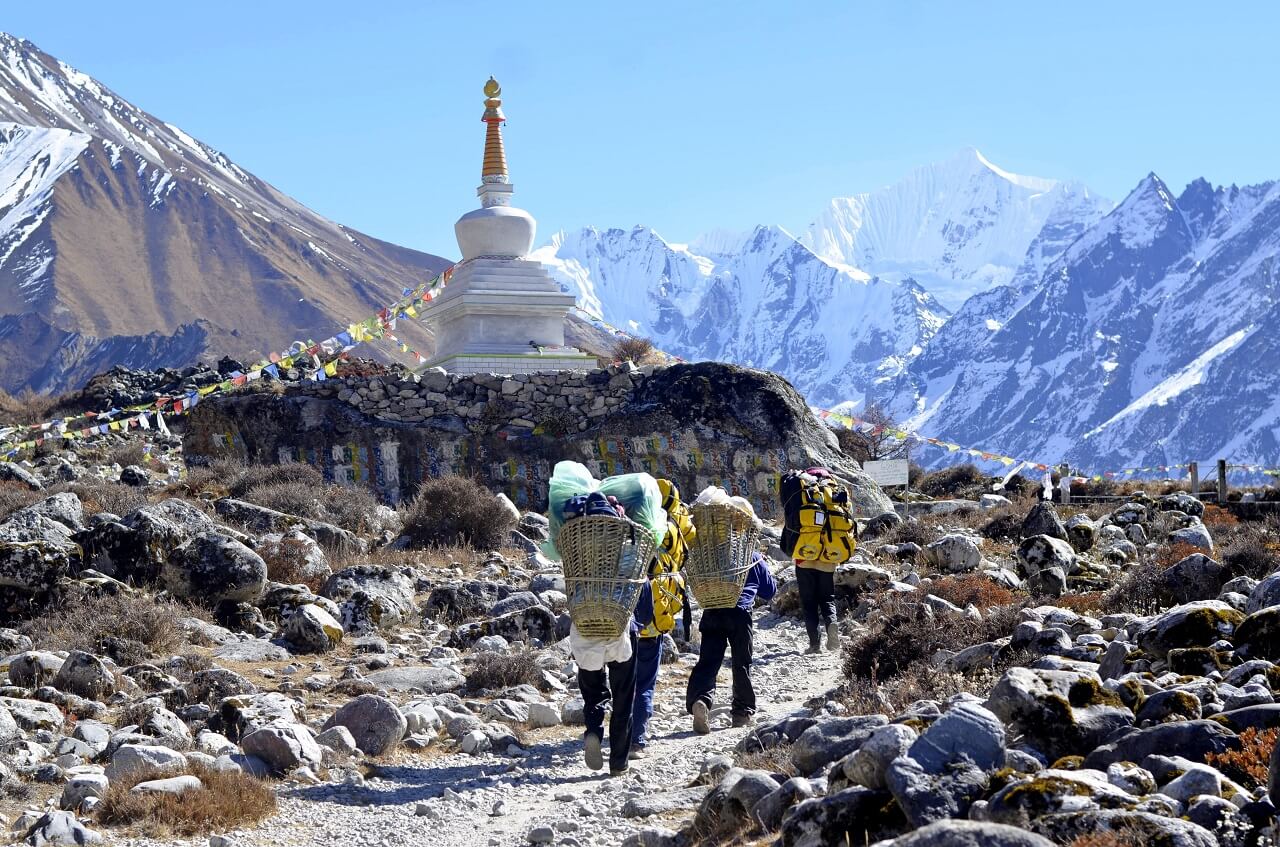
Bags:
- Duffel Bags
- Daypack
Clothing:
- Trekking Shirt: Pack at least 5 to 7 shirts balancing both long and short.
- Trekking Trousers: Carry a minimum of 2 trekking trousers with a couple of shorts.
- Base Layer: Pack a couple of wool base layers to stay protected from the cold in the upper reaches of the trek.
- Insulation Layer: We recommend you pack a high-quality fleece jacket.
- Outer Layer: Carry a warm and waterproof jacket for extreme weather.
- Waterproof Shell Jacket: Pack a pair of waterproof jackets for wet weather.
- Breathable Underwear: Minimum 5 to 6 pairs of breathable underwear.
Footwears:
- Hiking Boots: Invest in high-quality waterproof hiking boots. Make sure the boot is lightweight and comfortable.
- Trainers/Sandals: It is handy to carry a pair of trainers or sandals.
- Hiking Socks: You should carry 4-6 pairs of breathable hiking socks.
- Thermal Socks: A pair of thermal socks to keep your feet protected from the cold in the higher altitudes.
Head Wears:
- Sun Protection Hat: Carry a protection hat to protect your face from the harsh sun.
- Beanie: An absolute must to keep yourself warm, especially during the evening and night.
- Buff/Neck Gaiter: This small piece of gear comes in handy to protect your neck from the cold winds and also helps you stay protected from the dust.
Hand Wear:
- Inner Gloves: Pack light inner gloves as they can be useful when the temperature is moderate.
- Outer Gloves: You’ll be wearing them in the upper reaches of the trek. Outer gloves need to be insulated, warm, and waterproof.
Sleeping Bags:
Sleeping bags are the most crucial gears while trekking in the Langtang region. With basic rooms and sleeping facilities, you can never rely on the teahouses for warm, decent blankets.
Therefore, we advise you to invest in a high-quality, 4-season sleeping bag while trekking in Langtang.
Important Accessories:
- Trekking Poles
- Water Bottle
- Basic Medical Kits
- UV Protection Sunglasses
- Headlamp
- Water Purification Tablets
- Hand Sanitizers
- Sunscreen/Lip Balm
- Toiletries
- Trekking Towels
- Portable Chargers
Network Information
Both Ncell and NTC networks do not work in the Langtang Valley. Once you depart from Kathmandu, NTC services are not available, and Ncell works only up to Lama Hotel. Sky Network is the most preferred telecommunication service in the Langtang Valley. Sky Network works throughout the entire trek, from the lower reaches up to the higher elevations.
Remember, phone services may not be consistent throughout the entire region. Due to the inconsistency of networks, the mobile internet will also be unstable. However, most of the teahouses do provide WiFi facilities, but it might cost you a few extra bucks.
The majority of the teahouses in Langtang have landline phones. In case of emergencies, landline phones are the best way to connect with your emergency contacts.
Useful Tips for Langtang Valley Trekking
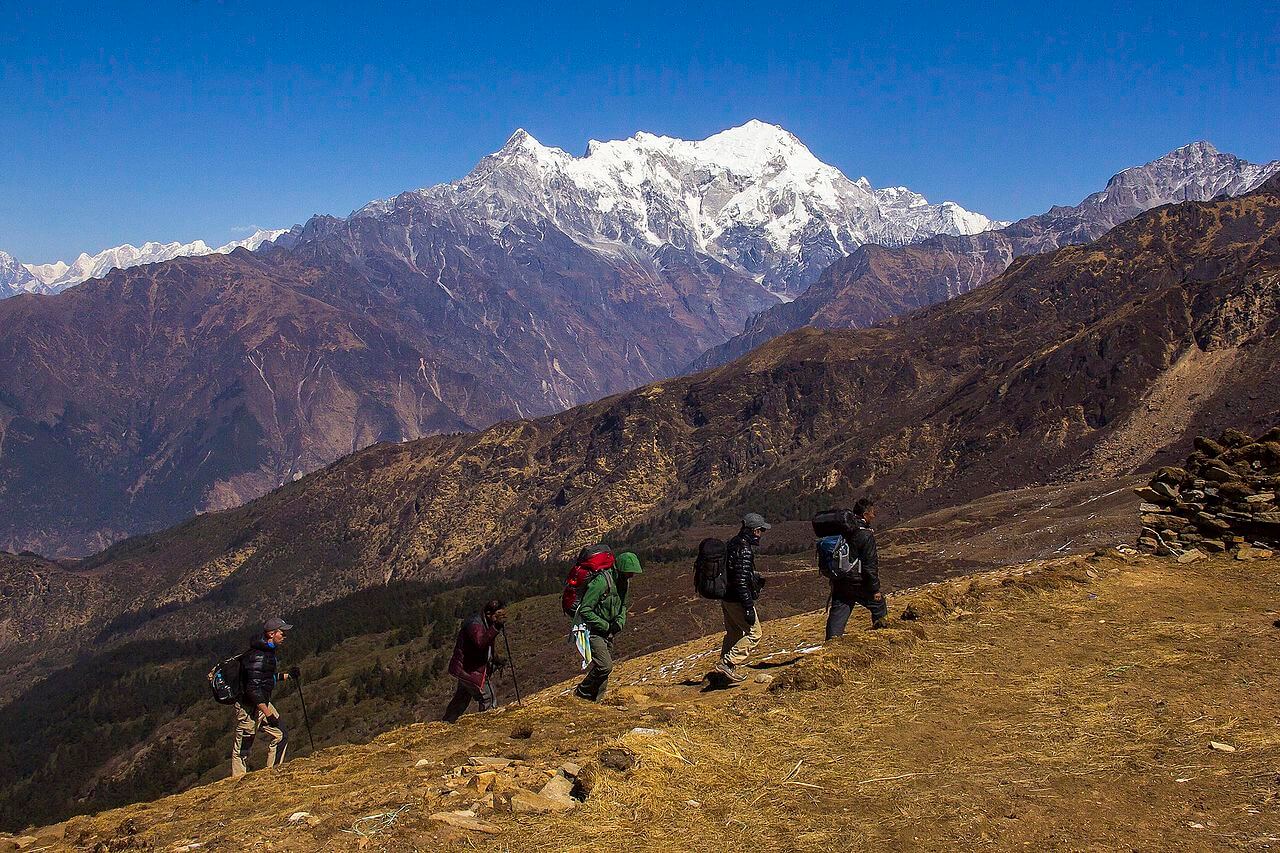
- While trekking in the upper reaches of Langtang Valley, you’re in a constant threat of suffering from acute mountain sickness (AMS). It is crucial to drink more water and take all the necessary precautions to protect yourself from altitude sickness.
- Packing the right equipment is essential while trekking to Langtang Valley. If you do not wish to buy all the expensive trekking gears, we advise you to rent them in Kathmandu.
- Although Langtang Valley Trek is a relatively moderate trek, it requires a certain level of physical fitness. We suggest you engaging in cardio-oriented activities like cycling, swimming and running, a month before the trek.
- It is not advisable to buy bottled waters as they pollute the trekking trail. We highly recommend you to fill up the water at the teahouses and use water purifiers to treat the water.
- Invest in high-quality hiking boots. If you’re planning to trek to Langtang Valley during monsoon or winter, buy waterproof boots that have sturdy soles.
- Before you go for trekking to Langtang Valley, get proper travel insurance that covers both medical costs and helicopter evacuation.
- Carry enough cash on the trek. ATMs are not available on the trail.
Accommodation in Kathmandu
| Budget Hotels | Mid-Range Hotels | Luxury Hotels |
|---|---|---|
| WanderThirst Hostel | Nepal Cottage Resort | Dwarikas Hotel |
| Andes House | The Fern Residency | Hyatt Regency |
| Hotel Trekkers Home | Hotel Vaishali | Kathmandu Guest House by KGH Group |
| Zen Bed and Breakfast | Shambaling Boutique Hotel | Hotel Shanker |
| Mitra Garden Inn | DOM Himalaya Hotel | Hotel Yak & Yeti |
Recommended Travel Agencies for Langtang Valley Trek
Recommended Books and Guidebooks
- A Trekking Guide to Langtang
- Lonely Planet Nepal (Travel Guide)
- The Rough Guide to Nepal
- Trekking in Langtang, Helambu & Gosainkund
- Climate Change and the Extreme Events in the Himalayas
- High Adventure
- The Snow Leopard
FAQs
1. Is it possible to do the Langtang Valley Trek solo/independently?
Langtang Valley Trek is a short and moderate walk in the Himalayas of Nepal. It is possible to do solo as well as in a group. The trail does not diverge in multiple routes and it occasionally marks the signposts. So, the trekkers do not stray off the path.
2. How likely am I to suffer from Acute Mountain Sickness in Langtang Valley Trek?
Keep in mind, Langtang Valley Trek exceeds the elevation of 3000m above sea level. Once you cross the height of 3000m, the possibility of suffering from altitude sickness becomes higher. Therefore, it is crucial to drink more water and take the necessary precautions to stay safe from AMS.
3. What type of accommodation can I expect in Langtang Trek?
In the lower region of Langtang, there are plenty of high standard lodges and teahouses that provide quality services. However, these teahouses are relatively expensive than the common one.
In the upper reaches of the trek, the teahouses offer rooms in sharing basis and other basic facilities.
4. Is it safe to drink water in Langtang Valley Trek?
No, it is not safe to drink water directly from local streams or taps while trekking in the Langtang region. Bottled water is quite expensive on the trail. It is advisable to carry your bottle and fill the water in the teahouses. Carry water purifiers or SteriPen purifiers to treat the water before drinking.
5. Do I need travel insurance before trekking to Langtang Valley?
While travel insurance is not mandatory, it is highly advisable to have one in high altitude treks. Even though Langtang Valley is a short and moderate, trekking in such high elevation is risky. Therefore, it is advisable to have proper travel insurance that covers all the necessary costs.
Conclusion
Langtang Valley Trek is a short and moderate trek in the Himalayas of Nepal. Easily accessible from Kathmandu, this trek is an excellent opportunity that rewards trekkers with authentic experience and warm hospitality.
Langtang Trek is an ideal choice for people who are looking to escape the massive crowd of Everest and Annapurna. It offers a diverse landscape, unique culture, beautiful scenery, and panoramic mountain spectacles.
Langtang Valley is also a perfect adventure destination to discover rare wildlife and plants. Carrying a decent camera is highly advisable as this trek offers plenty of opportunities to capture picture-perfect photographs.
